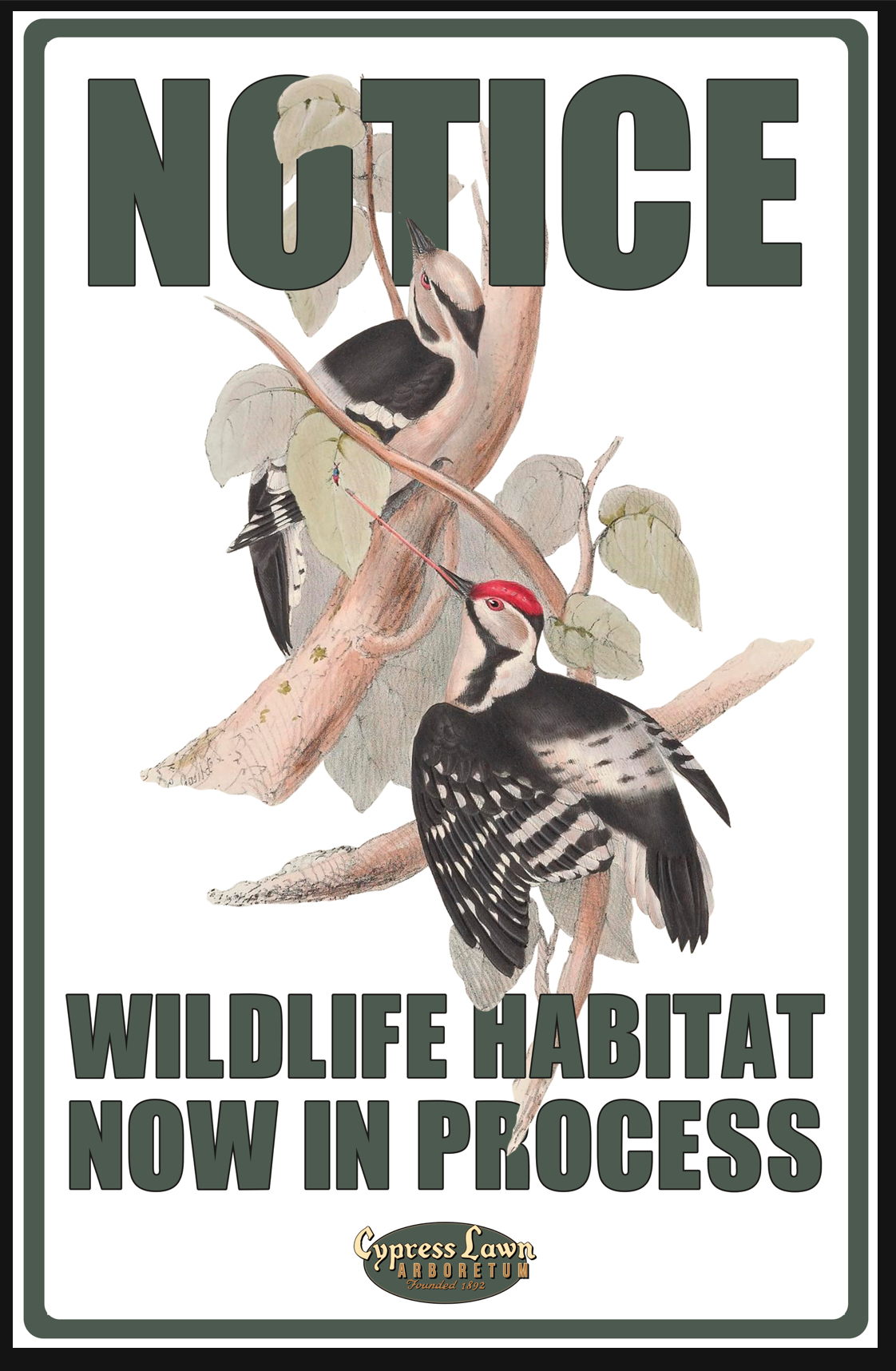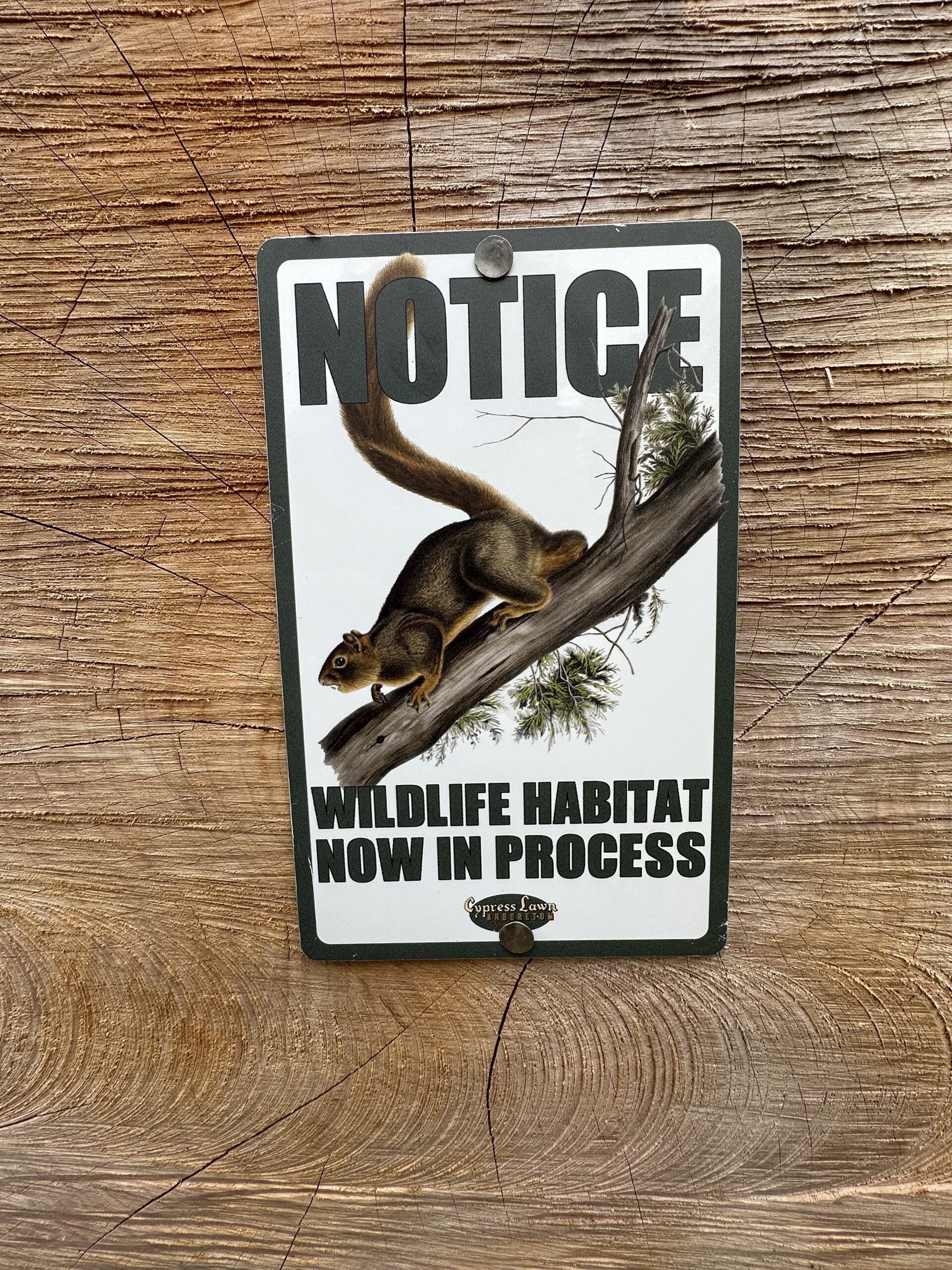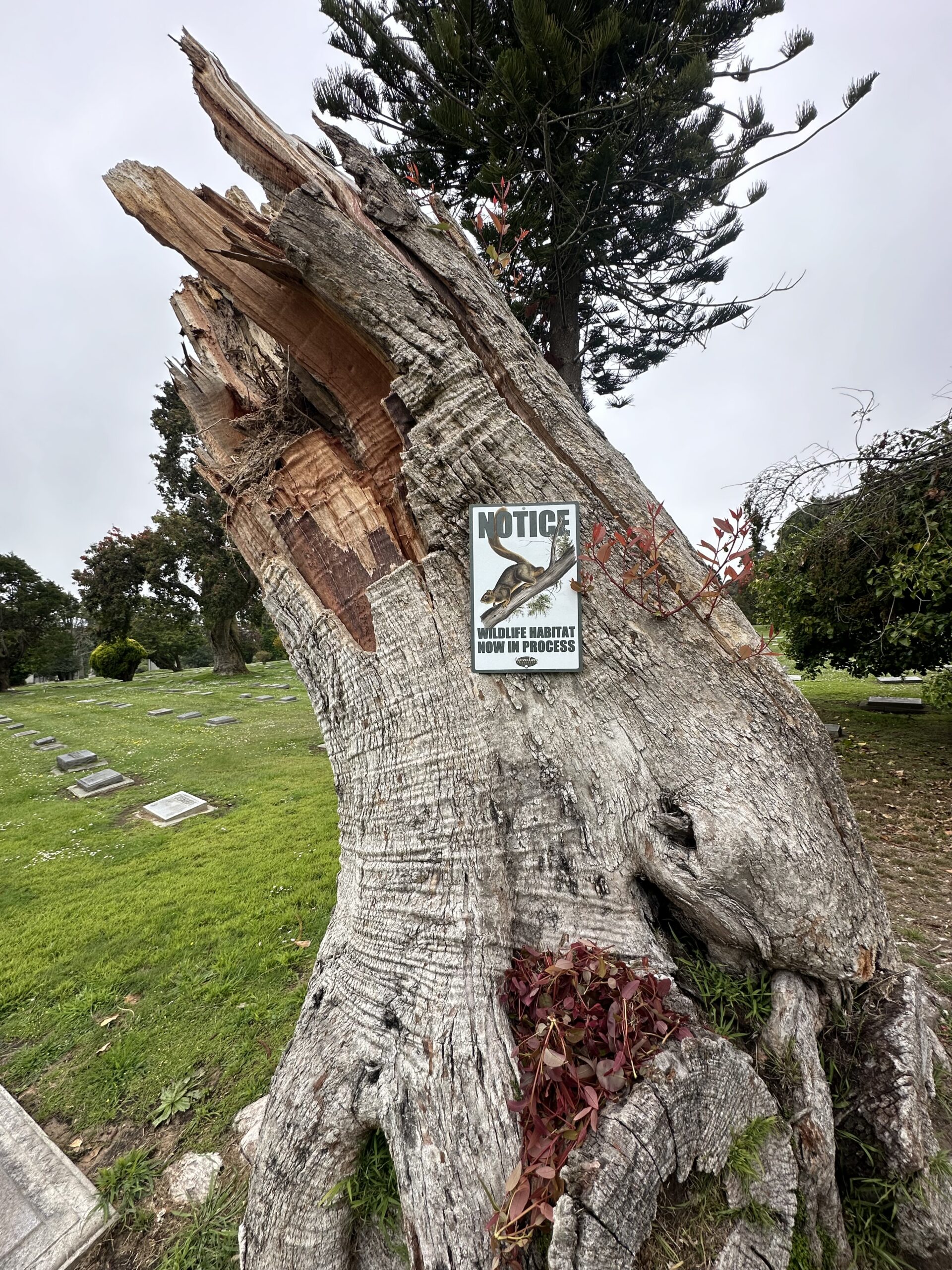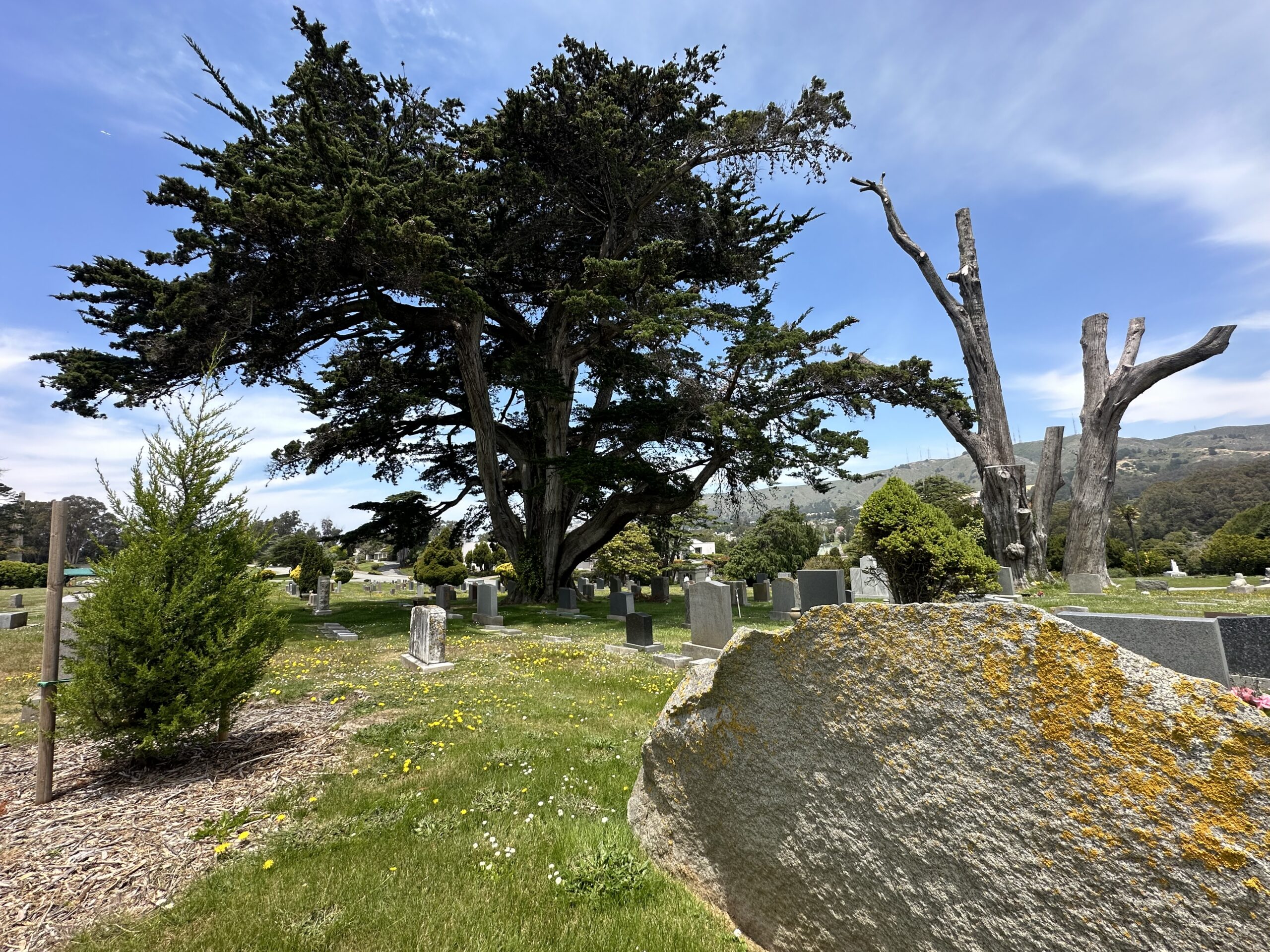
While walking through the grounds of Cypress Lawn Arboretum and Memorial Park, you may notice a new grounds management practice that our team of stewards and caretakers is beginning to embrace in this meaningful place of old trees – this is the way of giving trees a second life by safely preserving dead, dying, and decaying plants for their value as wildlife habitat.
This signage, and more interpretive storytelling visible in the landscape as you walk, drive, or wander about, will be a growing program of sharing in the seasons to come. The intention of such signage is to communicate with all visitors of Cypress Lawn, and especially for those who come to witness our remarkable collection of trees and the wide diversity of wildlife that calls them home, even when a docent or storyteller is not present to share. So, consider this as an open invitation, to explore the Arboretum on your own!

There is an immense known value of trees as a source of life to birds, insects, small mammals, and other creatures. This includes the provision of food from foliage, seeds, and fruits; shelter and perch places, such as in the lower skirt of shrubs and amongst the high branches of the tallest trees; and also nesting sites, places to rest and to raise a family, which are particularly desirable by many species in the hollows and cavities of decaying parts of trees.
With this awareness in mind, it may not come as a huge surprise that some of the best wildlife habitat, in natural forests and woodland areas, is actually provided by dead trees, in the forms of spars or snags (standing dead) and also as nurse logs (trees that have already fallen and lay at rest on the ground). Owls and squirrels will often nest in the hollow of an old oak, and various woodpeckers that create their own cavities prefer roosting on trees with sound wood on the outside of the trunk but a central column of decay on the interior.
As urbanization and development of open space increases year after year, unfortunately most old, dying, and dead trees are just removed from the landscape, considered as a hazard with little or no value to society. As this urban trend proceeds, wildlife habitat in the urban forest decreases, slowly withering away any potential for human beings to witness the wonders of the natural world. So, where is a woodpecker to go?
 Here! At Cypress Lawn Arboretum, we are and will continue to work to thoughtfully and responsibly steward our mature veteran trees to provide ecosystem services to the birds, bees, and beings that may not have many other places to live.
Here! At Cypress Lawn Arboretum, we are and will continue to work to thoughtfully and responsibly steward our mature veteran trees to provide ecosystem services to the birds, bees, and beings that may not have many other places to live.
Of course, risk management of big, old trees is a priority as well, and known extreme risk plants with valuable targets in the drop-zone will not go unmitigated, but we are choosing now to retain and even enhance desirable wildlife features in the landscape that do not pose an unacceptable level of risk.
Particularly for a collection of post-mature trees at an old cemetery like Cypress Lawn, the opportunity for safely preserving spars, snags, and nurse logs will be a major potential into our shared future. In addition to wood reclamation projects like our collection of wood benches scattered throughout the property, as well as the wood recycling program of mulch rings and mulched beds in various areas of our grounds, spars and logs are perhaps the most valuable method of reimagining the purpose of dead trees here at the Arboretum.

In some cases, dying trees or trees that have experienced major branch failures in recent seasons, such as the specimen of Corymbia ficifolia photographed to the right, will also be selectively retained. For this species, commonly known as the red-flowering gum, resprouting from latent buds along the trunk will give this failed tree a second generation of growth, a real ongoing life for the tree itself. Beyond this, though, the quality habitat provided by this plant as a home for many other beings will give a value beyond words, for many seasons ahead.
Arboriculture is a practice of balance, of intentional care implemented in consideration over a wide spectrum of values. At one end of this range, hazards and risks have historically led to full removal of old trees in the urban forest; essentially erasing their presence from the landscape entirely. In this framework, human beings and threats to our wellness are most heavily weighted in a decision-making management process. Features of old trees like small dead branches, delaminating bark, and cavities of a variety of sizes may be viewed as defects, merely increasing the likelihood of that tree part to fail and cause harm to people.

In some cases, dying trees or trees that have experienced major branch failures in recent seasons, such as the specimen of Corymbia ficifolia photographed to the right, will also be selectively retained. For this species, commonly known as the red-flowering gum, resprouting from latent buds along the trunk will give this failed tree a second generation of growth, a real ongoing life for the tree itself. Beyond this, though, the quality habitat provided by this plant as a home for many other beings will give a value beyond words, for many seasons ahead.
Arboriculture is a practice of balance, of intentional care implemented in consideration over a wide spectrum of values. At one end of this range, hazards and risks have historically led to full removal of old trees in the urban forest; essentially erasing their presence from the landscape entirely. In this framework, human beings and threats to our wellness are most heavily weighted in a decision-making management process. Features of old trees like small dead branches, delaminating bark, and cavities of a variety of sizes may be viewed as defects, merely increasing the likelihood of that tree part to fail and cause harm to people.
On the other end of the spectrum, however, these very same defects may also be viewed from the vantage of wildlife value as the best homes, the most desirable perches, and the safest roosts for a vulnerable fledgling family. It really is all a matter of perspective; when we can safely respect the risks posed to us, and thoughtfully factor those considerations into tree care, may we not also think of the birds while we work?
So, I invite you, next time you find a moment to take a walk through Cypress Lawn Arboretum, notice the diverse life taking flight all around you, embrace the presence of the beings of the more-than-human-world. If you choose to, you may just find that all that life out there enriches the experience of your own…
